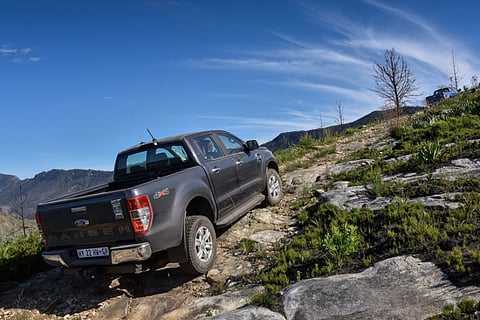Ford Ranger gets new engines & other tweaks, improving the winning formula
By Miles Downard
There's a new Ford Ranger here in South Africa, not that you'd be able to tell given its outward appearance. It's basically unchanged on the skin but peel away the layers and one starts to uncover quite a number of changes that go toward making the Ranger more refined, more economical and in some ways, more a leisure vehicle.
Behind the wheel
The rear suspension has been tweaked by moving the location of the anti-roll bar which has made the ride more refined. It's no more than an incremental change really, as the Ranger is still a way off being as comfortable as something like an Everest, which has proper independent rear suspension. The Ranger of course still needs to be able to cart heavy loads in the bin. It's nonetheless a noticeable improvement.
Then there's the entire powertrain which is all new. Alongside the now-established 3.2 litre 5 cylinder turbo diesel, or 2.2 litre turbo diesel is a relatively diminutive 2.0 litre four pot. You have the choice of either a single turbo or a bi-turbo setup, the former offering 132kW and 420Nm while the big boy gets 157kW and 500 torques mated to a new 10 speed automatic. Both the new units are assembled right here in South Africa, at Ford's Port Elizabeth plant, with the bi-turbo unit also doing duty in the soon to be launched Ford Raptor.
The new 10 speed automatic gearbox has already proven itself in the F-150 truck and is versatile enough to also be used in the Mustang. It's a clever unit with functions such as being able to lock out selected gears from the automatic shifting range, which can be beneficial when towing, driving in slippery conditions or climbing a steep gradient.
The single turbo unit is probably the most surprising as it just doesn't feel as laggy as I would have expected, meaning you get nice smooth torque delivery throughout the rev range. Mated with the 10 speed automatic gearbox it does hunt up and down the cogs but the ratios are all fairly close to one another so it's hardly noticeable. This has the benefit of being more efficient at the pumps; we averaged well under 10l/100km on the tarmac sections of the route.
The bi-turbo unit, only available in the Wildtrak, relies on a variable-geometry high-pressure turbocharger along with a fixed-geometry low-pressure unit. The two turbochargers work in series at lower engine speeds for better torque and responsiveness. At higher engine speeds, the smaller turbo is bypassed and the larger turbo provides boost to deliver high power. The result feels very strong indeed and also offers up better efficiency than the 3.2 litre unit.
On the inside
As the Ranger, especially in double cab format, is becoming more and more of a leisure vehicle over and above it's primary function as a workhorse, Ford has placed further focus on adding creature comforts and various innovative safety features to the Ranger. For example the range topping Wildtrak now has parallel park assist to accompany adaptive Cruise Control with Forward Collision Alert, Lane-Keeping Alert and Lane-Keeping Aid, and Auto High Beam Control. On the infotainment side of things the XLT and Wildtrak models are equipped with Ford's Sync 3 system that has navigation and smartphone integration, linked to the integrated eight-inch touch-screen colour display.
Pricing
The new engine derivatives, only available in double cab XLT and Wildtrak form, hit the shelves at a smidge over R510,000 through to just shy of R680,000. For my money the XLT 4×4 is the sweet spot.
Verdict
There really isn't a hell of a lot to dislike here. The Ranger has become very car-like in its offering, so from a creature comfort and feature offering there's little more I'd want from any vehicle I'd be driving on a daily basis. In 4×4 format the Ranger is very capable off road over and above the normal-bakkie-practicality of the 4×2. Now the addition of the new engines adds that extra level of choice for customers who lean more toward the leisure end of the workhorse scale. All round an absolutely top offering.
2.0 SiT XLT 10AT 4×2 – R514,300
2.0 SiT XLT 10AT 4×4 – R570,200
2.0 BiT Wildtrak 10AT 4×2 – R632,300
2.0 BiT Wildtrak 10AT 4×4 – R678,200

